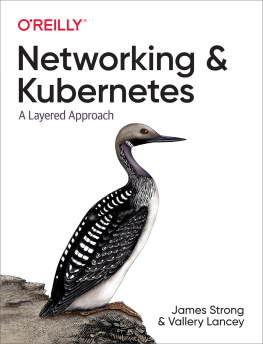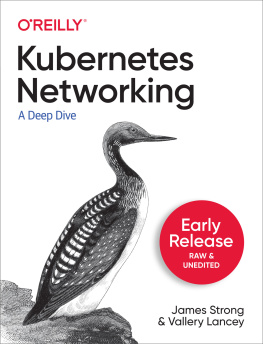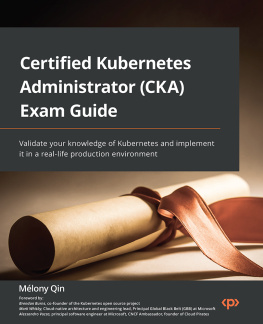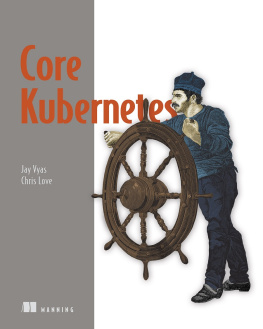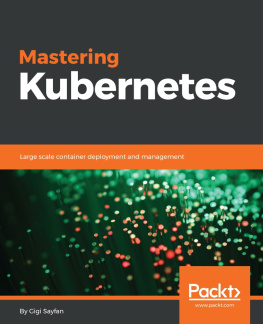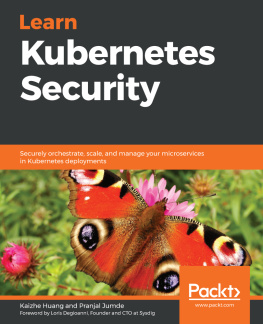Networking and Kubernetes
by James Strong and Vallery Lancey
Copyright 2021 Strongjz tech and Vallery Lancey. All rights reserved.
Printed in the United States of America.
Published by OReilly Media, Inc., 1005 Gravenstein Highway North, Sebastopol, CA 95472.
OReilly books may be purchased for educational, business, or sales promotional use. Online editions are also available for most titles (http://oreilly.com). For more information, contact our corporate/institutional sales department: 800-998-9938 or corporate@oreilly.com .
- Acquisitions Editor: John Devins
- Development Editor: Melissa Potter
- Production Editor: Beth Kelly
- Copyeditor: Kim Wimpsett
- Proofreader: Piper Editorial Consulting, LLC
- Indexer: Sam Arnold-Boyd
- Interior Designer: David Futato
- Cover Designer: Karen Montgomery
- Illustrator: Kate Dullea
- September 2021: First Edition
Revision History for the First Edition
- 2021-09-07: First Release
See http://oreilly.com/catalog/errata.csp?isbn=9781492081654 for release details.
The OReilly logo is a registered trademark of OReilly Media, Inc. Networking and Kubernetes, the cover image, and related trade dress are trademarks of OReilly Media, Inc.
The views expressed in this work are those of the authors, and do not represent the publishers views. While the publisher and the authors have used good faith efforts to ensure that the information and instructions contained in this work are accurate, the publisher and the authors disclaim all responsibility for errors or omissions, including without limitation responsibility for damages resulting from the use of or reliance on this work. Use of the information and instructions contained in this work is at your own risk. If any code samples or other technology this work contains or describes is subject to open source licenses or the intellectual property rights of others, it is your responsibility to ensure that your use thereof complies with such licenses and/or rights.
978-1-492-08165-4
[LSI]
Preface
Just Another Packet
Since the first two computers were joined together over a cable, networking has been a crucial part of our infrastructure.Networks now have layers and layers of complexity to support a multitude of use cases, and the advent of containers and projects like Mesosphere and Kubernetes have not changed that. While the contributors of Kubernetes have attempted to abstract away this networking complexity for developers, computer science is just that, abstraction upon abstraction. Kubernetes, and its networking API, is another abstraction that makes it easier and faster to deploy applications for consumption. What about the administrator who has to manage Kubernetes? This book intends to dispelthe mysticism around the abstractions Kubernetes puts in place, guide administrators through the layers of complexity,and help you realize Kubernetes is not just another packet.
Who This Book Is For
According to 451 Research, the global application container market is expected to grow from USD 2.1 billion in 2019 to USD 4.2 billion by 2022 . This explosive growth in thecontainer market underscores the need for IT professionals to be knowledgeable in deploying, managing, and troubleshooting containers.
This book is intended to be read from beginning to end by new network, Linux, or cluster administrators, and it can be used by more experienced DevOps engineers to jump to specific topics forwhich they find themselves needing to be upskilled. Network, Linux, and cluster administrators need to be familiar with how to operate Kubernetes at scale.
In this book, readers will find the information required to navigate the layers of complexity that come with running a Kubernetes network. This book will peel back the abstractions that Kubernetes puts in place so that developers have a similar experience across deployments on-premises, in the cloud, and with managed services. Engineers responsible for production cluster operations and network uptime can use this book to bridge the gap in their knowledge of those abstractions.
What You Will Learn
By the end of this book, the reader will understand the following:
- The Kubernetes networking model
- The Container Network Interface (CNI) project and how to choose a CNI project for their clusters
- Networking and Linux primitives that power Kubernetes
- The relationship between the abstractions powering the Kubernetes network
Also, the reader will be able to do the following:
- Deploy and manage a production-scale network for Kubernetes clusters
- Troubleshoot underlying network-related application issues inside a Kubernetes cluster
Conventions Used in This Book
The following typographical conventions are used in this book:
ItalicIndicates new terms, URLs, email addresses, filenames, and file extensions.
Constant widthUsed for program listings, as well as within paragraphs to refer to program elements such as variable or function names, databases, data types, environment variables, statements, and keywords.
Constant width boldShows commands or other text that should be typed literally by the user.
Constant width italicShows text that should be replaced with user-supplied values or by values determined by context.
Tip
This element signifies a tip or suggestion.
Note
This element signifies a general note.
Warning
This element indicates a warning or caution.
Using Code Examples
Supplemental material (code examples, exercises, etc.) is available for download at https://github.com/strongjz/Networking-and-Kubernetes.
If you have a technical question, or a problem using the code examples, please send email to .
This book is here to help you get your job done.In general, if example code is offered with this book, you may use it in your programs and documentation.You do not need to contact us for permission unless youre reproducing a significant portion of the code.For example, writing a program that uses several chunks of code from this book does not require permission.Selling or distributing examples from OReilly books does require permission.Answering a question by citing this book and quoting example code does not require permission.Incorporating a significant amount of example code from this book into your products documentation does require permission.
We appreciate, but generally do not require, attribution.An attribution usually includes the title, author, publisher, and ISBN. For example: Networking and Kubernetes by James Strong and Vallery Lancey (OReilly).Copyright 2021 Strongjz tech and Vallery Lancey, 978-1-492-08165-4.
If you feel your use of code examples falls outside fair use or the permission given above, feel free to contact us at .
OReilly Online Learning
Note
For more than 40 years, OReilly Media has provided technology and business training, knowledge, and insight to help companies succeed.
Our unique network of experts and innovators share their knowledge and expertise through books, articles, and our online learning platform.OReillys online learning platform gives you on-demand access to live training courses, in-depth learning paths, interactive coding environments, and a vast collection of text and video from OReilly and 200+ other publishers.For more information, visit

